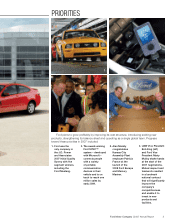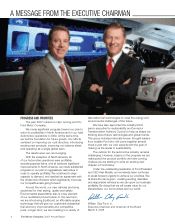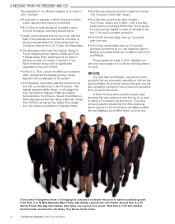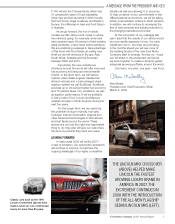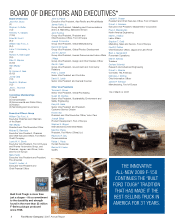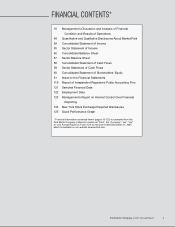Ford 2007 Annual Report Download - page 14
Download and view the complete annual report
Please find page 14 of the 2007 Ford annual report below. You can navigate through the pages in the report by either clicking on the pages listed below, or by using the keyword search tool below to find specific information within the annual report.
Management’s Discussion and Analysis of Financial Condition and Results of Operations
12 Ford Motor Company | 2007 Annual Report
Emissions Standards for Medium and Heavy Trucks. New, more stringent U.S. regulatory requirements for truck
emissions took effect on January 1, 2007, which increased the cost primarily of diesel engines used in medium and heavy
trucks. These standards did not apply to vehicles purchased prior to the implementation of the new regulations. As a
result, sales of medium and heavy trucks were elevated in 2006 as buyers pulled ahead orders that they would otherwise
have made at a later date. The payback from this pull-ahead demand, which may continue into 2008, contributed to a
30% year over year decline in sales of medium and heavy trucks in 2007.
Trends and Strategies
The global automotive marketplace has become increasingly fragmented and crowded, and we anticipate that this
trend will continue to accelerate into the future. Anticipating little growth in the overall volume of vehicles sold in North
America for the foreseeable future, we expect more manufacturers to offer an increasing number of products in this
market. To address this market reality and the factors and trends affecting the automotive industry discussed above, and
towards the end of achieving profitable growth in all markets, we have been focusing and continue to focus on the
following four key priorities:
• Aggressively restructure to operate profitably at the current demand and changing model mix;
• Accelerate development of new products our customers want and value;
• Finance our plan and improve our balance sheet; and
• Work together effectively as one team.
Aggressively Restructure to Operate Profitably at the Current Demand and Changing Model Mix
To compete more effectively in today's global marketplace, and particularly in North America, we have been executing
a plan to restructure aggressively our Automotive business to address the realities of lower demand, higher fuel prices
and the shifting model mix from trucks and large SUVs to more fuel-efficient vehicles.
On January 23, 2006, we announced a major business improvement plan for our North American Automotive
operations, which we referred to as the Way Forward plan. On September 15, 2006, responding to changing facts and
circumstances, we announced an acceleration of this plan, including actions designed to further reduce operating costs
and increase the flow of new products. Key elements of our plan to restructure aggressively our Automotive business
include the following:
Personnel reductions
To contribute to our goal of reducing annual North America operating costs by about $5 billion by the end of 2008 as
compared with 2005, over the last two years we have reduced by about 46,300 the employment levels in our Ford North
America business unit. At December 31, 2007, our Ford North America business unit had approximately 23,700 salaried
employees and 64,000 hourly employees (including 6,100 working at our ACH facilities), compared with approximately
34,500 salaried employees and 99,500 hourly employees (including 13,900 working at our ACH facilities) at
December 31, 2005. Most of these reductions were the result of offers of early retirement or separation packages to U.S.
employees, including Ford employees at our ACH plants.
Although we have achieved our previously announced goal to operate with between 55,000 to 60,000 hourly non-ACH
employees in North America by the end of 2008, we have embarked on additional personnel reduction actions, as
announced on January 24, 2008, to achieve even lower hourly employment levels in North America. With the UAW, we
are implementing an additional enterprise-wide buyout program in two phases:
•
The first phase is applicable to UAW-represented employees at select closed facilities (i.e., the Atlanta, St. Louis,
Edison (NJ) and Norfolk Assembly Plants), with buyout offers running from January 22, 2008 to February 25, 2008.
Employees who accept these offers generally will be separated by March 1, 2008.
•
The second phase is applicable to all other UAW-represented employees, with buyout offers being made from
February 19, 2008 to March 18, 2008. Employees who accept these offers will be separated beginning
April 1, 2008, with most separations completed by June 30, 2008 and all completed by year-end 2008.



